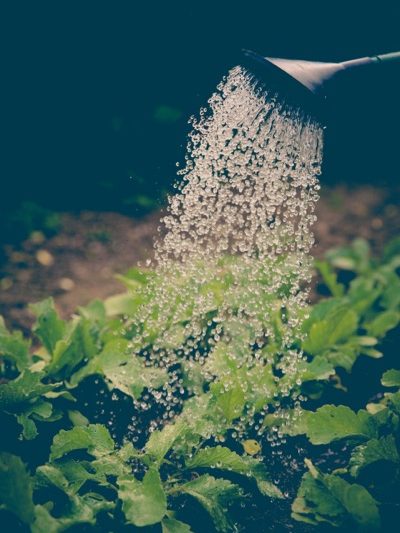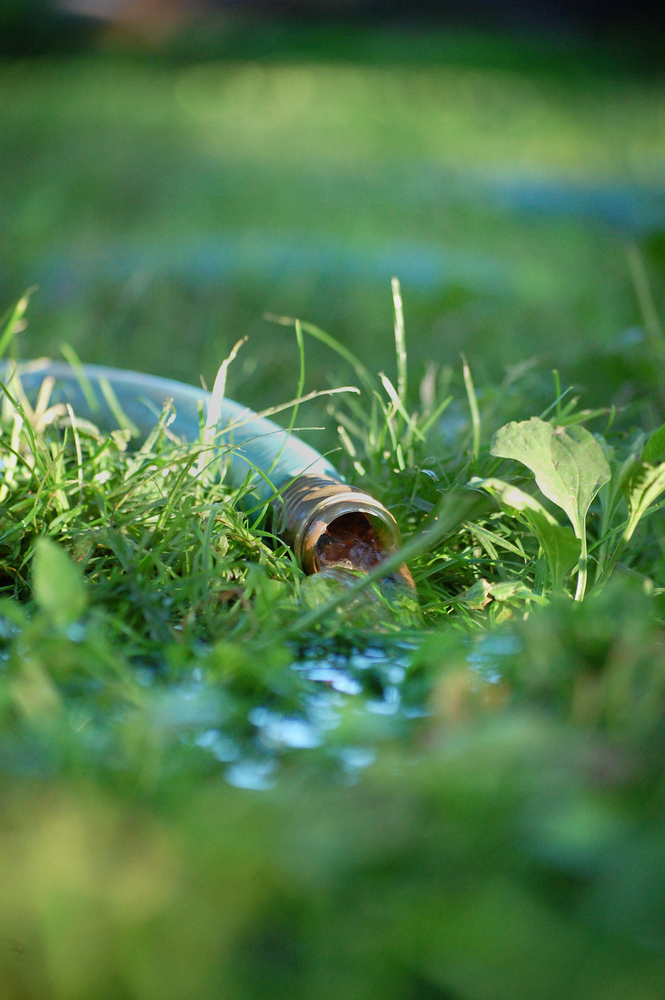
Watering your Garden
We hear this question all the time, “How much should I water my garden?” There is no one-size-fits-all answer here and there are several factors to take into consideration.
According to “Desert Landscaping for Beginners,” by the Arizona Master Gardeners, water makes up 90% of plant weight. It forms a continuous liquid pipeline within the plant that promotes growth and it cools the plant by means of transpiration. Therefore, understanding a plant’s water needs is vital for success. Incorrect watering is at the top of the list when it comes to plant problems.
Ask These Questions First
What is planted? Drought tolerant plants versus those that are tropical will have different needs.
Is it fully grown? The watering of a fully grown tree will be different from a sapling. This is because a fully grown tree has a the deep root structure required to go in search of water, whereas a sapling does not.
Where is it planted? In-ground or raised bed or container? You will also need to consider how well that area drains.
How much sun does it get? Plants in a well-shaded area of the garden will require less frequent watering than something in full sun.
Will you be hand watering, using an irrigation system or receiving flood irrigation? Even with flood irrigation or an irrigation system, you may need to give trees and additional manual soaking in between.
What season is it? How much sun and heat is the plant getting greatly affects how much water it needs.
How much water will the tree or plant require by the time it is matured?
Signs that Your Plants are Water Stressed
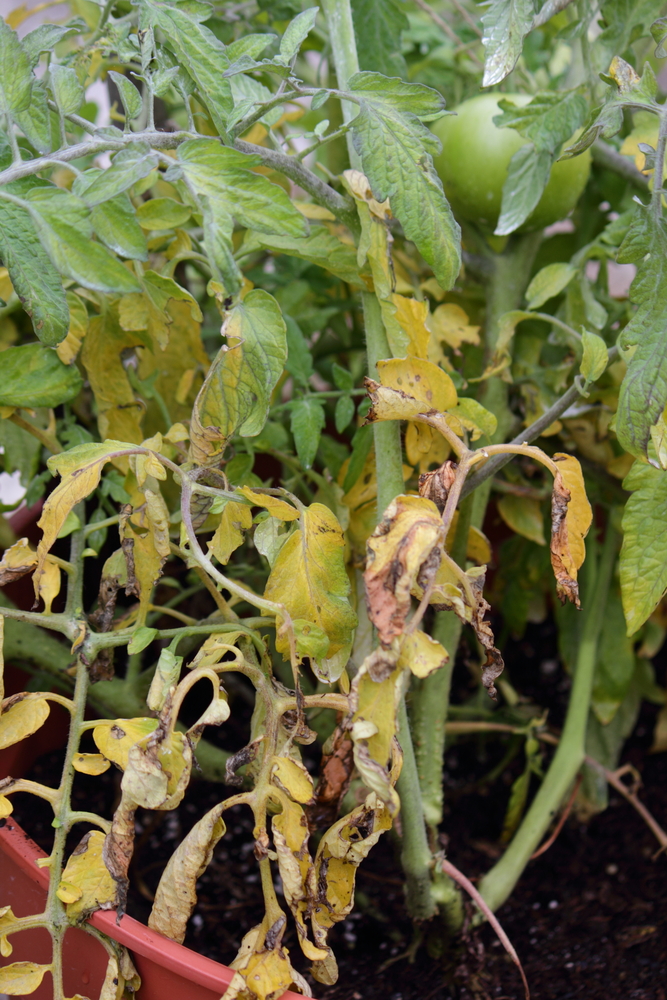
OVERWATERING
Could mean too little oxygen in the soil for plant roots
This prevents proper nutrient uptake leaving plants deficient and vulnerable to pest attacks and diseases. Tree leaves curling under is a sign that a tree may be getting too much water. This also leads to defoliation. In veggies, the foliage color will start to change to a pale yellowing across the entire plant.
Mushrooms popping up could indicate very moist soils. However, mushrooms are not harmful and also a sign that there is good soil life.
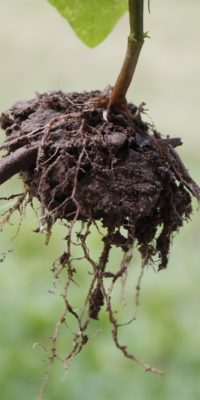
SHALLOW WATERING
Is just as serious of an issue
Shallow watering leads to poor root systems that stay close to the surface of the soil. This means high temperatures coupled with dry winds could cause faster drying of trees and other plants.
It could also mean trees blow over easier in Monsoon winds. Shallow watering will also cause salt build up as salts move through the soil with water. Therefore, if water is not reaching deep down into the soil, salts build up around the already shallow roots. Salt burn shows up in leaves as a browning of the tips, then leaf margins, before the entire leaf eventually dries out. Next, the plant will start defoliating.
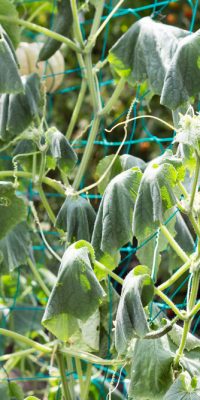
UNDER WATERING
It's just as easy to under as to overwater
Plants will show water stress when they do not have enough water by wilting. Some tree leaves will also curl up to reduce transpiration. Eventually, plants will get dry and crunchy and trees will start to defoliate. Some Deciduous trees will actually go into dormancy early from a lack of water.
Certain plants like squashes and eggplants will wilt during the heat of the day. However, most will regain turgidity once it cools down. This is a response to not being able to take up water fast enough in the heat.
Checking Moisture Levels
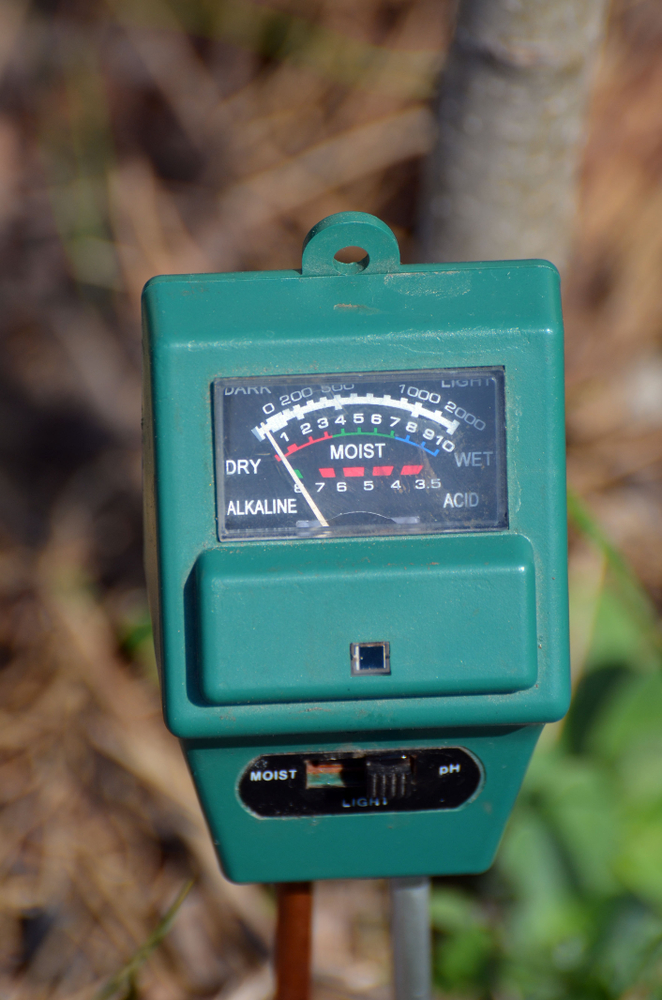
Soil probe
The most efficient way to check moisture levels is with a reliable water meter that has a long probe. This will give you a good indication of whether soils are dry, sufficiently wet, or medially moist.
Finger Test
Until you get a moisture meter, the finger test is the next best option. Stick your finger into the soil to about the depth of a knuckle. You should be able to tell if the soil is moist or dry. However, this method does not give a good indication of whether deeper soils are wet.
Each time you water
The soil should be wet to the root zone of the plant or beyond
Vegetables and Flowers
Vegetables and flowers 12-16 inches. Most are good at 12 inches but some like okra, corn, and artichokes which have deeper roots will go as deep as 16 inches.
Shrubs and Bushes
Shrubs and bushes like roses, hibiscus, and blackberries need water to a depth of about 18-24 inches.
Trees
Trees have a rooting depth of around 3 feet when they are more mature.
Checking Tree Moisture Depth
To check if water levels are reaching deep enough for trees, you can use a soil probe. If you don’t have one, a 4’ piece of rebar or even a long screwdriver will work. After watering, it should easily go 3ft deep into the soil. Allow soils to dry out about 50% before watering again. The moisture meter can help you determine this. Clay soils will take longer to dry out, therefore plants in ground will require less frequent watering than those in containers or raised beds.
Plants will use the most water on exceptionally hot days and windy days. Even in cooler temperatures, the wind is a very drying factor.
Easy Watering Tips
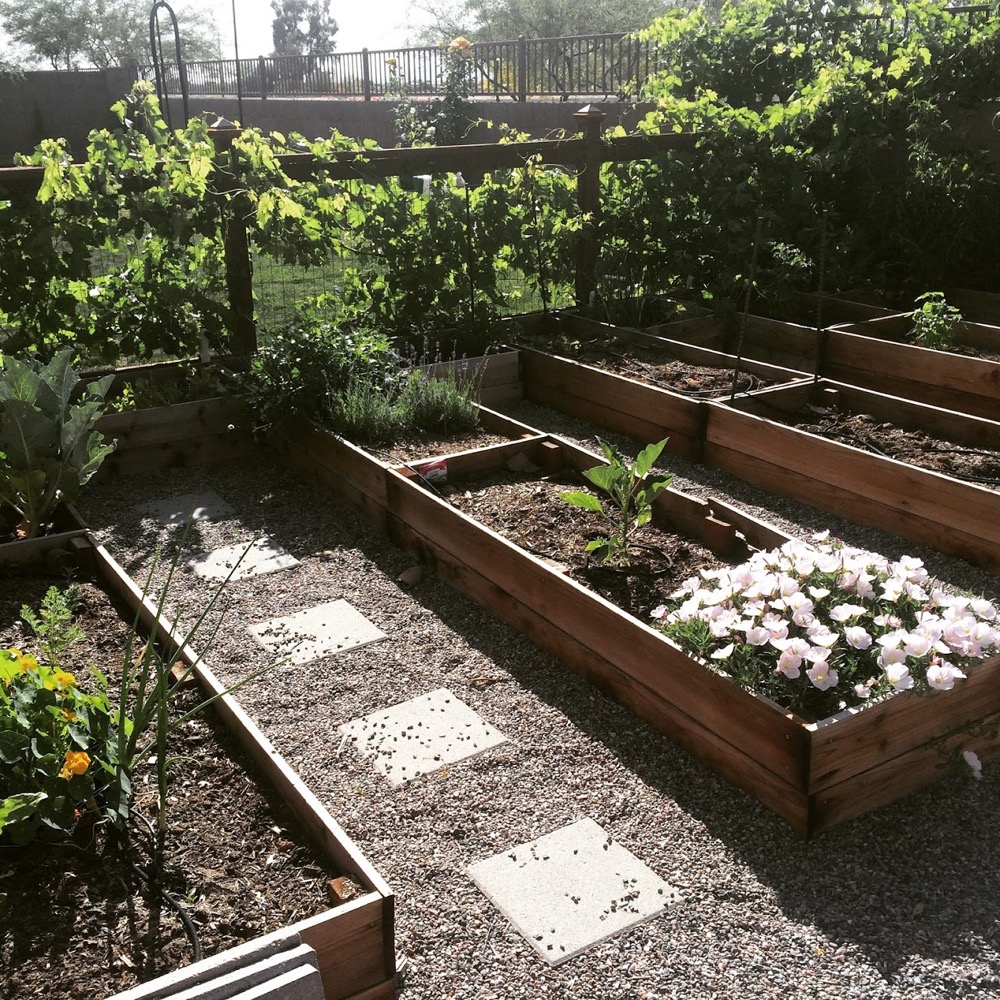
Potted Plants and Raised Beds
Always use native clay in your pots and raised beds to help retain moisture.
Once temperatures are about 90F, check moisture levels every day. After checking a few times, you will have a pretty good idea of how quickly things are drying out. At this point, you will be watering every day or every other day. Different plants will dry out at different rates. At Solitary Bee Gardens, potted roses in fifteen gallon containers are not really a year old. Their root systems are not fully developed and therefore right now, in May, they are receiving water once a week, whereas a Kadota fig tree in the same size pot needs to be watered three times a week.
Also keep in mind that the size of a pot and raised bed impacts how quickly it dries out. A 5’ x 10’ raised bed will retain more moisture than a 2’ x 5’ bed as long as it is watered correctly/deeply. Therefore, a smaller bed will need to be watered more often. We do not recommend pots smaller than fifteen gallons because they dry out too quickly and become too hot in the summer.
Once temperatures are in the 100’s, you will more than likely be watering everyday whether you hand water or you have the pots/beds hooked up to an irrigation system.

In-Ground Plantings
Typically, in-ground vegetable gardens will need to be watered less frequently than potted and raised bed gardens, roughly every 3-4 days. However, check your moisture meter readings to determine the frequency. The number of plants, size of plants, and density of plants, as well as the soil condition will affect how often you water. If plants are planted closely, they will shade soils and moisture will be conserved. However, different types of plants will still have different requirements. Corn planted densley in a raised bed will shade soils and that will help to conserve water, but corn also needs plenty of water. Due to the very deep root system, you will not likely be watering corn everyday. A bed of tomatoes and basil, however, will require more frequent waterings in lesser amounts.
When reading instructions for watering trees, remember that young trees will require less water, but more frequent waterings than fully mature trees. For example, mature citrus is watered every 2 weeks in the summer in the low desert and once a month in winter. A young tree will need to be watered every 2-3 days in the summer and approximately every 10 days in winter. On floor irrigated lots, irrigation is normally once every two weeks in summer, but you will still need to manually supplement water for young trees. Keep in mind that the bulk of most tree roots are in the top 24 inches of soil and spread laterally to mirror the canopy of the tree. However, you want to water deeper than 24 inches to push the salts in the ground deeper and away from your trees roots. To properly water an in-ground tree, you should fill the well around it (which is as large as the tree canopy) 1-3 times and allow the water to soak in each time. Tree roots naturally search for water at the drip edge of the canopy because this is where rain water naturally drips from the leaves.
We highly recommend the Rainbird irrigation system. For tree wells, bubblers work better than drip emitters. Keep in mind, the root system of a plant is about 1.5-4 times as wide as the tree canopy. Bubblers or ¾” soaker hose also work well for in-ground veggie gardens.
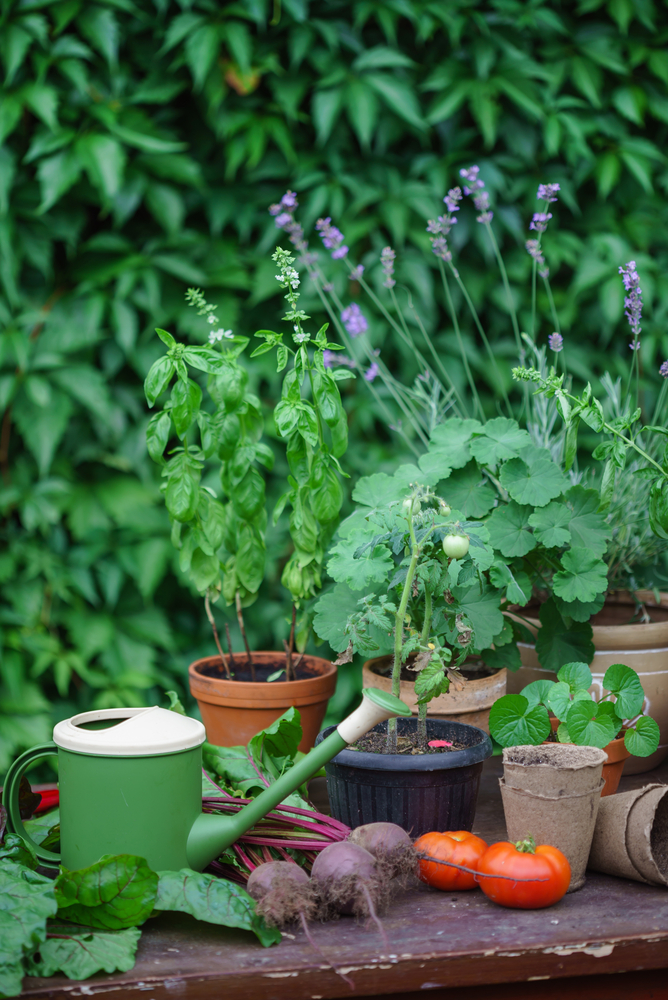
All Planting Situations
Use a calendar to keep track of watering schedules. Google Calendar is a great free option that allows you to setup repeat reminders at different intervals and color code them.
Water in the morning, that ensures there is enough water for plants to take up during transpiration.
Monsoon rains! Each rainfall will really only replace one normal watering. Do not make the mistake of leaving plants unwatered for a week in the summer because we got one monsoon rain.
Use at least a 3 inch layer of mulch to retain moisture.
Drip Irrigation System Tips
A drip system with a one-gallon-per-hour emitter and a 15-minute run timely puts out 1 quart of water. A garden hose running for 2-3 seconds also puts out a quart of water. Make sure your drip system is running long enough for a good deep soak. If you have an existing drip system, you can check the flow rate of the drippers by looking at the color.
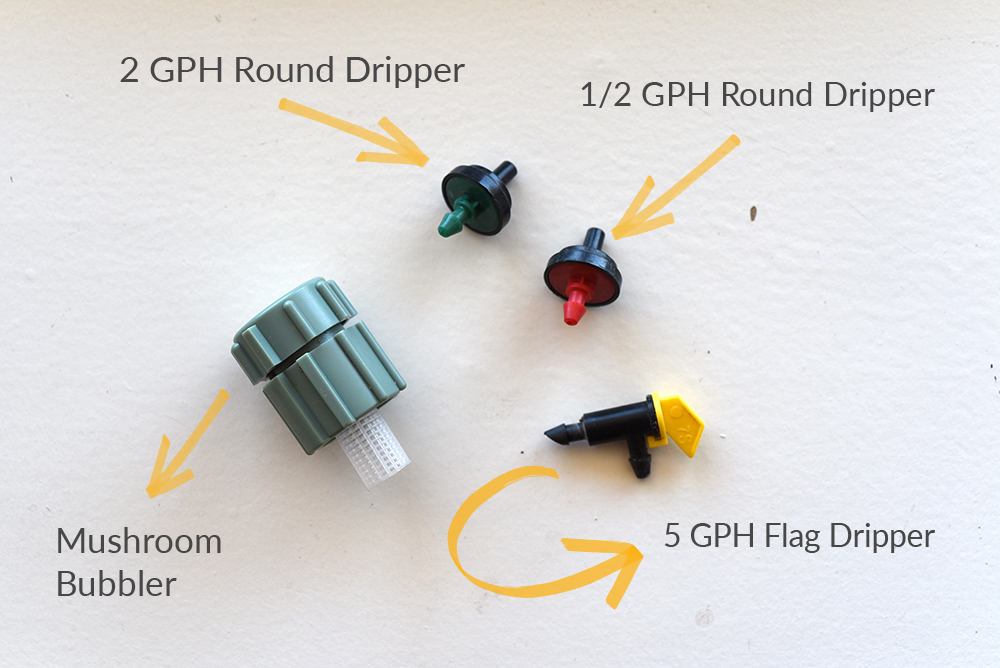
- Black round drippers are usually 1 gallons per hour (GPH)
- Red round drippers are usually .5 GPH
- Green round drippers are between 2-4 GPH
- Green flag drippers are between 2-3 GPH
- Yellow flag drippers are 5-6 GPH
We don’t suggest ever watering anything larger than a medium sized shrub with drippers since these usually do not deep water plants enough to ensure a healthy root system and wash salt away (unless you leave them on for a long, long, long time). If you have an irrigation system, a mushroom bubbler is a good option for tree wells as it has an adjustable flow up to 2.5 gallons per MINUTE, not hour.
Some Thoughts on Water Quality
Arizona water quality is very poor. It is high in salts which adds to the alkalinity and other issues we may experience with our plants. Invest in a good water filter that attaches to a hose bib if you are hand watering or using soaker hoses.
Filtering Hose Water
We recommend this garden hose filter to remove salts, chemicals, and pesticides.
You may also want to consider harvesting rain water, which is not only cleaner (no salts, chlorine, chemicals from city water) but also rich in nitrogen. When rain falls from the sky, it captures nitrogen in the air as it falls and makes it available to plants as it soaks into the soil. Harvesting rainwater can be as simple as placing a bucket to capture water that falls off your roof. More complex systems involve gutters and large rain barrels, but collect more water with less effort.

